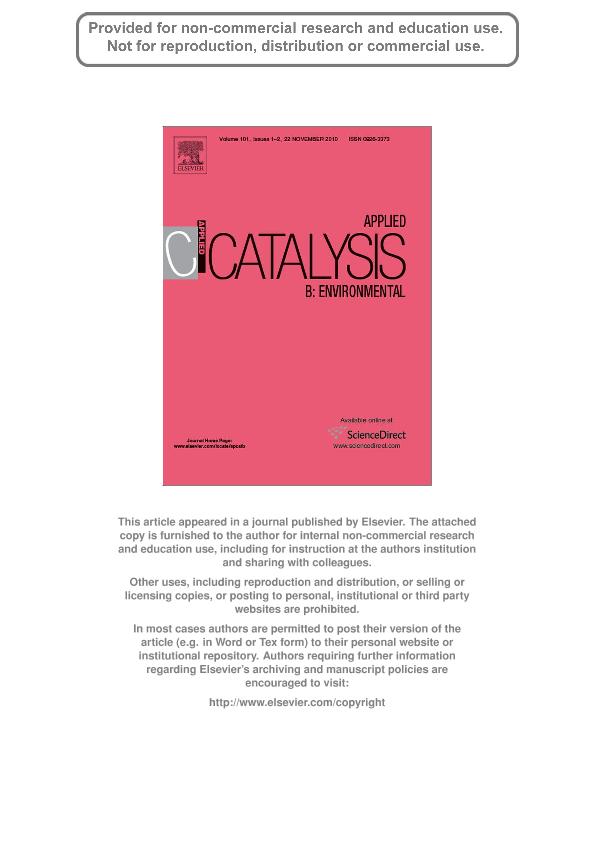Mostrar el registro sencillo del ítem
dc.contributor.author
Peralta, María Ariela

dc.contributor.author
Ulla, Maria Alicia del H.

dc.contributor.author
Querini, Carlos Alberto

dc.date.available
2019-04-11T20:58:05Z
dc.date.issued
2010-11
dc.identifier.citation
Peralta, María Ariela; Ulla, Maria Alicia del H.; Querini, Carlos Alberto; Diesel soot and NOx abatement: K/La2O3 catalyst stability; Elsevier Science; Applied Catalysis B: Environmental; 101; 1-2; 11-2010; 38-44
dc.identifier.issn
0926-3373
dc.identifier.uri
http://hdl.handle.net/11336/74169
dc.description.abstract
Soot particles and nitrogen oxides are the main pollutants emitted by a diesel engine. In this work, the activity and the stability of the KOH/La2O3 catalyst are studied. This catalyst is able to adsorb NOx, which is a good property for the catalyst in order to be used as a NOx trap. In addition, it is active for soot combustion as determined by temperature-programmed oxidation analyses. FTIR, XRD, CO2-TPD, Pulses of CO2, and BET techniques are used in order to characterize the catalysts. The catalytic surface composition depends upon the relative partial pressures of H2O, CO2, NO and O2. Despite the different surface compositions, the catalytic activity remains quite stable, under operation conditions similar to those of a real diesel exhaust. High temperature treatments, such as 800°C, and especially in the presence of water, leads to an irreversible catalyst deactivation due to potassium volatilization. The water condensed on the catalyst, could wash-out a fraction of the potassium from the outer surface, leading to a decrease in activity. However, when the catalyst is treated at 400°C, potassium diffuses from inside the pores to the external surface, thus recovering activity for soot combustion.
dc.format
application/pdf
dc.language.iso
eng
dc.publisher
Elsevier Science

dc.rights
info:eu-repo/semantics/openAccess
dc.rights.uri
https://creativecommons.org/licenses/by-nc-nd/2.5/ar/
dc.subject
Deactivation Mechanism
dc.subject
Diesel Soot
dc.subject
Lanthanum
dc.subject
Potassium
dc.subject
Stability
dc.subject.classification
Otras Ingeniería Química

dc.subject.classification
Ingeniería Química

dc.subject.classification
INGENIERÍAS Y TECNOLOGÍAS

dc.title
Diesel soot and NOx abatement: K/La2O3 catalyst stability
dc.type
info:eu-repo/semantics/article
dc.type
info:ar-repo/semantics/artículo
dc.type
info:eu-repo/semantics/publishedVersion
dc.date.updated
2019-04-01T16:15:00Z
dc.journal.volume
101
dc.journal.number
1-2
dc.journal.pagination
38-44
dc.journal.pais
Países Bajos

dc.journal.ciudad
Amsterdam
dc.description.fil
Fil: Peralta, María Ariela. Consejo Nacional de Investigaciones Científicas y Técnicas. Centro Científico Tecnológico Conicet - Santa Fe. Instituto de Investigaciones en Catálisis y Petroquímica "Ing. José Miguel Parera". Universidad Nacional del Litoral. Instituto de Investigaciones en Catálisis y Petroquímica "Ing. José Miguel Parera"; Argentina
dc.description.fil
Fil: Ulla, Maria Alicia del H.. Consejo Nacional de Investigaciones Científicas y Técnicas. Centro Científico Tecnológico Conicet - Santa Fe. Instituto de Investigaciones en Catálisis y Petroquímica "Ing. José Miguel Parera". Universidad Nacional del Litoral. Instituto de Investigaciones en Catálisis y Petroquímica "Ing. José Miguel Parera"; Argentina
dc.description.fil
Fil: Querini, Carlos Alberto. Consejo Nacional de Investigaciones Científicas y Técnicas. Centro Científico Tecnológico Conicet - Santa Fe. Instituto de Investigaciones en Catálisis y Petroquímica "Ing. José Miguel Parera". Universidad Nacional del Litoral. Instituto de Investigaciones en Catálisis y Petroquímica "Ing. José Miguel Parera"; Argentina
dc.journal.title
Applied Catalysis B: Environmental

dc.relation.alternativeid
info:eu-repo/semantics/altIdentifier/doi/http://dx.doi.org/10.1016/j.apcatb.2010.08.031
dc.relation.alternativeid
info:eu-repo/semantics/altIdentifier/url/https://www.sciencedirect.com/science/article/pii/S0926337310003930
Archivos asociados
